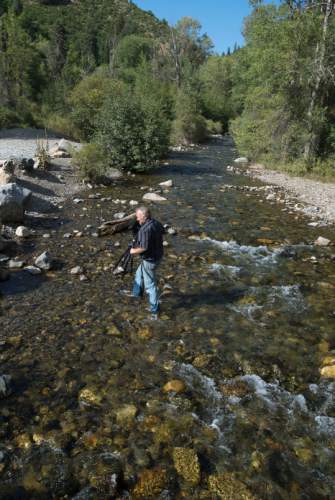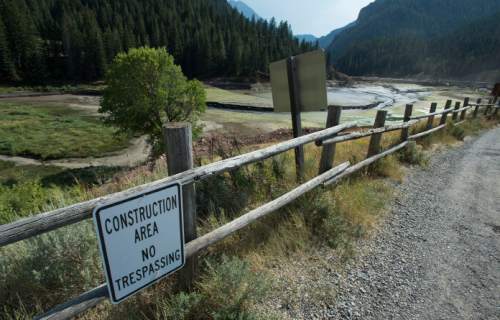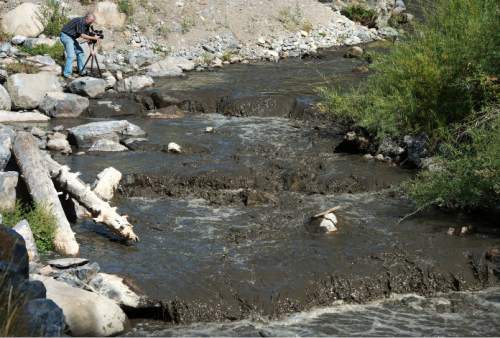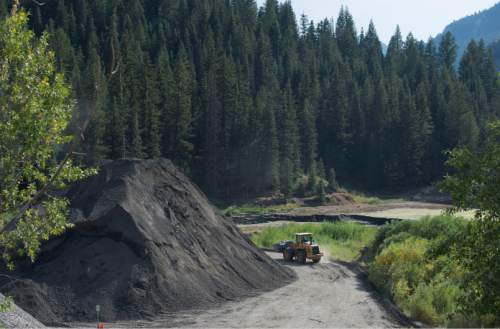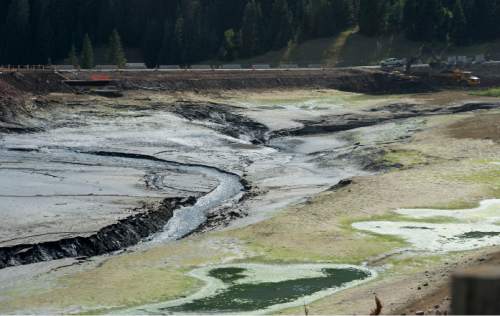This is an archived article that was published on sltrib.com in 2016, and information in the article may be outdated. It is provided only for personal research purposes and may not be reprinted.
Some of the sediments that have turned American Fork River's normally clear waters into a black soup could be loaded with arsenic, lead and other toxic metals associated with historical mining operations at the scenic canyon's headwaters.
Officials from several local, federal and state agencies gathered at Tibble Fork Dam on Tuesday to figure out what to do about the sediment releases, which commenced sometime after the 10-acre lake began draining Saturday as part of $7.3 million project to upgrade the aging earthen structure.
The incident shocked conservationists who fear an ecological catastrophe is unfolding in one of Utah's most popular natural areas, located in the Wasatch Mountains just outside Provo.
"I think it's a $20 million cleanup and it will take years," said Mark Allen, founder of the group Protect and Preserve American Fork Canyon.
The North Utah County Water Conservancy District sponsored the project with federal matching dollars in an effort to make the dam seismically safe and extend its life for another 50 years. The lake bed is coated with 5 to 10 feet of fine-grained black sediments that have accumulated behind the dam and impaired its ability to store water, though the lake has remained a popular, well-stocked trout fishery.
A sediment release "was not unexpected, given this was a rehabilitation project," said the district's lawyer, John Jacobs. "There may have been a bit more than was anticipated. This is a 60-year-old dam, and it has a lot of sediments behind it."
During the review process, federal officials had considered dredging the lake bed as a way to restore the dam's usefulness, but testing indicated that levels of arsenic and lead exceeded safety standards and made these sediments too dangerous to move, according to the environmental assessment conducted by the Natural Resources Conservation Service.
The metals contaminating Tibble Fork originated in Live Yankee, Globe and other abandoned gold and silver mines that perforate the head of American Fork Canyon's northern branch, according to Allen. He says the state is doing too little to hold landowners accountable for these environmental "time bombs." Many of these old mines are located on land now owned by Snowbird Ski Resort in and around its Mineral Basin.
The cost of extracting and disposing of the material accumulated in the Tibble Fork lake bed would be $8.4 million, so the option was abandoned in favor of raising the dam by 9 feet. The environmental assessment insisted the contractor use "best management practices" to ensure the toxic sediments were not pushed downstream.
The measures are detailed in a construction permit issued this year by the U.S. Army Corps of Engineers, which would not immediately provide a copy of the permit. It did send personnel to the dam Tuesday to determine whether the project was in compliance with the permit.
The U.S. Environmental Protection Agency also sent emergency-response personnel to the site.
"It was so damning that they didn't want to touch the sediment," Allen said. "It said it was too toxic to remove it, but now it's in the river. How are you going to clean up 10 miles of trout streams?"
The water district hired Provo-based RB&G Engineering to design the project and Whitaker Construction, of Brigham City, to build it. RB&G's project leader, Brad Price, did not immediately return a phone message seeking comment.
Allen and members of Trout Unlimited spent Monday in the canyon, photographing the sludge pouring down the river channel, which smelled of gunpowder and rotting fish.
"In the main canyon, the water looks like Mississippi mud," said Grant Bench, an officer with a Utah County Trout Unlimited chapter. "I don't know how a cold-water fish is supposed to survive in that."
But federal and state officials were not ready to declare a disaster Tuesday.
"We are taking samples above [the dam] and below to establish baseline and impact below in the water column," said Walt Baker, director of the Utah Division of Water Quality.
Division of Wildlife Resources aquatics biologist Mike Slater zapped the creek in various places with electroshock equipment Tuesday in search of breathing fish.
"We did an awful lot of testing," Slater said. "We have live fish in American Fork Canyon. We have no live fish in the north fork. There are no fish in the stream 2 miles below Tibble Fork Dam. At the mouth of the canyon it is an off color, but we had no problem finding live fish."
The condition of the river was markedly better Tuesday, according to Slater, but the dam was still disgorging sediment-filled water down Tibble Fork, which feeds the American Fork River 2 miles downstream. The water flowing down the canyon feeds secondary water and irrigation for farmers and residents around American Fork, Cedar Hills, Lehi and Highland.
"Doing nothing is not an option," Slater said. "How do we stop the bleeding? How do we stop what's taking place and put clean water in the river? You have to keep water in the canyon."
Brian Maffly covers public lands for The Salt Lake Tribune. Maffly can be reached at bmaffly@sltrib.com or 801-257-8713.
Twitter: @brianmaffly


